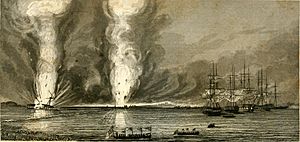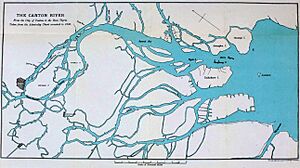Battle of First Bar facts for kids
Quick facts for kids Battle of First Bar |
|||||||
|---|---|---|---|---|---|---|---|
| Part of the First Opium War | |||||||
 Attack on the First Bar battery (published 1843) |
|||||||
|
|||||||
| Belligerents | |||||||
| Commanders and leaders | |||||||
| James Bremer Thomas Herbert |
Hsiang-fu (KIA) Yung-fu |
||||||
| Strength | |||||||
| 2 steamers 4 corvettes 1 bomb ketch |
2,000+ troops 40+ junks 1 East Indiaman |
||||||
| Casualties and losses | |||||||
| 1 died (due to an accident) 8 wounded |
300 killed 98 guns captured 1 East Indiaman destroyed |
||||||
The Battle of First Bar was an important fight during the First Opium War. It happened on February 27, 1841, near First Bar Island in China's Pearl River. This battle involved British forces fighting against Chinese troops from the Qing Empire. It was a key moment in the war, showing the strength of the British navy.
Contents
Preparing for Battle
Before the battle, Chinese officials were getting ready for a fight. On February 21, 1841, a leader named Lin Zexu noted that many soldiers had arrived in Canton. About 1,000 troops came from Hunan and another 1,000 from Yunnan.
Lin Zexu met with two important generals, Hsiang-fu and Yung-fu. They were preparing their forces. On February 24, Lin and other officials checked the defenses along the Pearl River. They spent the night near Canton, inspecting the area. Their inspection continued for a few days, finishing on February 26.
The Battle Begins
On the morning of February 27, 1841, several British ships sailed into the Pearl River. These ships included the Calliope, Herald, Alligator, Sulphur, Modeste, and two steamships, Madagascar and Nemesis.
As the ships moved, many Chinese people watched from the shore. Commodore James Bremer, the British commander, put Captain Thomas Herbert in charge of the fleet. They sailed past Tiger Island and reached First Bar Island by noon.
Chinese Defenses
At First Bar, the British saw a ship called Cambridge, which used to be a British merchant ship. It was now flying a Chinese admiral's red flag. The Chinese had built strong defenses along the river. These defenses had 47 cannons. Nearby, there were many white tents, showing that a large number of Tartar soldiers were present. More than 40 war junks (Chinese ships) were further up the river.
When the British steamships moved forward, the Chinese cannons started firing. The British ships fired back with shells and rockets. The Modeste got very close to the shore, about 300 yards away. It fired many shots at the Chinese defenses. Other British ships joined in the attack.
The Chinese soldiers fought bravely, but they could not stop the powerful British cannons. The shells and rockets from the Madagascar and Nemesis caused a lot of damage. They even set fire to parts of the Chinese camp. The Cambridge ship also fired its guns, but the British ships quickly overwhelmed it. Its crew jumped into the water to escape. The Chinese junks made a lot of noise, but they stayed far away from the British fleet.
Land Attack
After about an hour, most of the Chinese cannons were silent. British forces then landed on the shore. Captain Herbert reported that he led his sailors and marines to attack the Chinese positions. They pushed back over 2,000 Chinese soldiers and killed nearly 300.
Many Chinese soldiers tried to cross a deep part of the river to escape. However, many of them drowned or were shot. The British captured the forts about 30 minutes after landing.
Capturing the Cambridge
While the land battle was happening, British officers boarded the Cambridge ship. They quickly captured it after a short fight with the few Chinese crew members who remained. The ship had 34 cannons. The British commander ordered the ship to be set on fire.
Soon after dark, the fire reached the ship's gunpowder storage, causing a huge explosion. The masts and beams of the ship flew into the air. Captain Herbert said the explosion was so loud that people in Canton must have heard it.
Aftermath of the Battle
During the battle, the British captured a total of 98 Chinese cannons. The British had very few casualties. One sailor died by accident when his musket fired, and eight others were wounded.
On February 28, Lin Zexu learned about the battle. He heard that the British had broken through the Chinese defenses at Wu-yung. The Hunan soldiers had suffered heavy losses, and their commander, General Hsiang-fu, was killed. Lin also mentioned that 100 trained militiamen arrived too late to help in the fight. Later that afternoon, important Chinese officials, including Qishan, Deng Tingzhen, and Yiliang, held a meeting to discuss what had happened.


